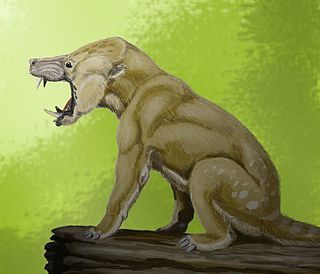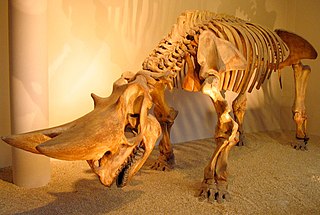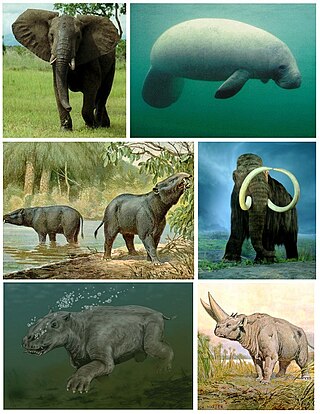
Perissodactyla is an order of ungulates. The order includes about 17 living species divided into three families: Equidae, Rhinocerotidae (rhinoceroses), and Tapiridae (tapirs). They typically have reduced the weight-bearing toes to three or one of the five original toes, though tapirs retain four toes on their front feet. The nonweight-bearing toes are either present, absent, vestigial, or positioned posteriorly. By contrast, artiodactyls bear most of their weight equally on four or two of the five toes: their third and fourth toes. Another difference between the two is that perissodactyls digest plant cellulose in their intestines, rather than in one or more stomach chambers as artiodactyls, with the exception of Suina, do.

The Sirenia, commonly referred to as sea cows or sirenians, are an order of fully aquatic, herbivorous mammals that inhabit swamps, rivers, estuaries, marine wetlands, and coastal marine waters. The extant Sirenia comprise two distinct families: Dugongidae and Trichechidae with a total of four species. The Protosirenidae and Prorastomidae families are extinct. Sirenians are classified in the clade Paenungulata, alongside the elephants and the hyraxes, and evolved in the Eocene 50 million years ago (mya). The Dugongidae diverged from the Trichechidae in the late Eocene or early Oligocene.

Ungulates are members of the diverse clade Euungulata, which primarily consists of large mammals with hooves. Once part of the clade "Ungulata" along with the clade Paenungulata, "Ungulata" has since been determined to be a polyphyletic and thereby invalid clade based on molecular data. As a result, true ungulates had since been reclassified to the newer clade Euungulata in 2001 within the clade Laurasiatheria while Paenungulata has been reclassified to a distant clade Afrotheria. Living ungulates are divided into two orders: Perissodactyla including equines, rhinoceroses, and tapirs; and Artiodactyla including cattle, antelope, pigs, giraffes, camels, sheep, deer, and hippopotamuses, among others. Cetaceans such as whales, dolphins, and porpoises are also classified as artiodactyls, although they do not have hooves. Most terrestrial ungulates use the hoofed tips of their toes to support their body weight while standing or moving. Two other orders of ungulates, Notoungulata and Litopterna, both native to South America, became extinct at the end of the Pleistocene, around 12,000 years ago.

The Desmostylia are an extinct order of aquatic mammals native to the North Pacific from the early Oligocene (Rupelian) to the late Miocene (Tortonian). Desmostylians are the only known extinct order of marine mammals.

Afrotheria is a superorder of mammals, the living members of which belong to groups that are either currently living in Africa or of African origin: golden moles, elephant shrews, otter shrews, tenrecs, aardvarks, hyraxes, elephants, sea cows, and several extinct clades. Most groups of afrotheres share little or no superficial resemblance, and their similarities have only become known in recent times because of genetics and molecular studies. Many afrothere groups are found mostly or exclusively in Africa, reflecting the fact that Africa was an island continent from the Cretaceous until the early Miocene around 20 million years ago, when Afro-Arabia collided with Eurasia.

Paenungulata is a clade of "sub-ungulates", which groups three extant mammal orders: Proboscidea, Sirenia, and Hyracoidea (hyraxes). At least two more possible orders are known only as fossils, namely Embrithopoda and Desmostylia.

Condylarthra is an informal group – previously considered an order – of extinct placental mammals, known primarily from the Paleocene and Eocene epochs. They are considered early, primitive ungulates. It is now largely considered to be a wastebasket taxon, having served as a dumping ground for classifying ungulates which had not been clearly established as part of either Perissodactyla or Artiodactyla, being composed thus of several unrelated lineages.

Mammalia is a class of animal within the phylum Chordata. Mammal classification has been through several iterations since Carl Linnaeus initially defined the class. No classification system is universally accepted; McKenna & Bell (1997) and Wilson & Reader (2005) provide useful recent compendiums. Many earlier ideas from Linnaeus et al. have been completely abandoned by modern taxonomists, among these are the idea that bats are related to birds or that humans represent a group outside of other living things. Competing ideas about the relationships of mammal orders do persist and are currently in development. Most significantly in recent years, cladistic thinking has led to an effort to ensure that all taxonomic designations represent monophyletic groups. The field has also seen a recent surge in interest and modification due to the results of molecular phylogenetics.

Paleoparadoxia is a genus of large, herbivorous aquatic mammals that inhabited the northern Pacific coastal region during the Miocene epoch. It ranged from the waters of Japan, to Alaska in the north, and down to Baja California, Mexico.

Embrithopoda ("heavy-footed") is an order of extinct mammals known from Asia, Africa and Eastern Europe. Most of the embrithopod genera are known exclusively from jaws and teeth dated from the late Paleocene to the late Eocene; however, the order is best known from its terminal member, the elephantine Arsinoitherium.

Tethytheria is a clade of mammals that includes the sirenians and proboscideans, as well as the extinct order Embrithopoda.

Panperissodactyla is a clade of ungulates containing living order Perissodactyla and all extinct ungulates more closely related to Perissodactyla than to Artiodactyla.

Ferungulata is a grandorder of placental mammals that groups together mirorder Ferae and clade Pan-Euungulata. It has existed in two guises, a traditional one based on morphological analysis and a revised one taking into account more recent molecular analyses. The Fereungulata is a sister group to the order Chiroptera (bats) and together they make clade Scrotifera.

Anthracobunidae is an extinct family of stem perissodactyls that lived in the early to middle Eocene period. They were originally considered to be a paraphyletic family of primitive proboscideans possibly ancestral to the Moeritheriidae and the desmostylians. The family has also thought to be ancestral to the Sirenia.

Sirenia is the order of placental mammals which comprises modern "sea cows" and their extinct relatives. They are the only extant herbivorous marine mammals and the only group of herbivorous mammals to have become completely aquatic. Sirenians are thought to have a 50-million-year-old fossil record. They attained modest diversity during the Oligocene and Miocene, but have since declined as a result of climatic cooling, oceanographic changes, and human interference. Two genera and four species are extant: Trichechus, which includes the three species of manatee that live along the Atlantic coasts and in rivers and coastlines of the Americas and western Africa, and Dugong, which is found in the Indian and Pacific oceans.

Phenacodontidae is an extinct family of large herbivorous mammals traditionally placed in the “wastebasket taxon” Condylarthra, which may instead represent early-stage perissodactyls. They lived from the late early Paleocene to early middle Eocene and their fossil remains have been found in North America and Europe. The only unequivocal Asian phenacodontid is Lophocion asiaticus.
Radinskya is an extinct perissodactyl-like mammal from the Paleocene of China. It is named after palaeontologist and perissodactyl expert Leonard Radinsky who died prematurely in 1985.
Eggysodontidae is a family of perissodactyls, closely related to rhinoceroses. Fossils have been found in Oligocene deposits in Europe, the Caucasus, Central Asia, China, and Mongolia.

Paenungulatomorpha is a clade of afrotherian mammals that can be characterized according to Gheerbrant et al. (2016):
by a mandibular retromolar fossa, the absence of hypocone, an ectoloph selenodont and linked to strong styles such as mesostyle in basal taxa, and a more or less developed pseudohypocone.
















